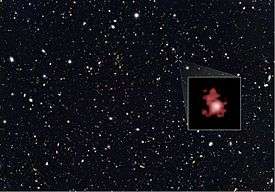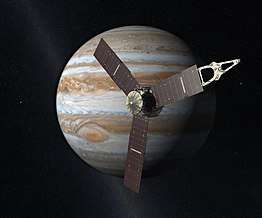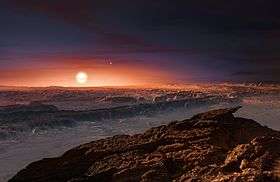2016 PQ
2016 PQ is an approximately 20-meter sized asteroid and near-Earth object of the Apollo group, with one of the smallest known minimum orbital intersection distances with Earth.
| Discovery [1][2] | |
|---|---|
| Discovered by | Pan-STARRS 1 |
| Discovery site | Haleakala Obs. |
| Discovery date | 2 August 2016 |
| Designations | |
| 2017 BS5 | |
| Orbital characteristics [1] | |
| Epoch 4 September 2017 (JD 2458000.5) | |
| Uncertainty parameter 7 | |
| Observation arc | (5 days) |
| Aphelion | 2.9431 AU |
| Perihelion | 0.8695 AU |
| 1.9063 AU | |
| Eccentricity | 0.5439 |
| 2.63 yr (961 days) | |
| 131.84° | |
| 0° 22m 28.2s / day | |
| Inclination | 2.6215° |
| 317.73° | |
| 53.512° | |
| Earth MOID | 0.000098 AU (0.038 LD; 14693 km; 2.3 R⊕) |
| Physical characteristics | |
| Dimensions | 20 m (est. at 0.20; 25.9)[3] |
| 25.9[1] | |
Discovery
The asteroid was discovered by the Pan-STARRS telescope on 2 August 2016, when it had reached magnitude 20.5, and it had brightened by magnitude 19.0 three nights later, after which it became too close to the Sun to spot with ground-based telescopes. It reached its closest approach to the Earth on 7 August 2016, at 0.025 AU, or 9.8 lunar distances.[1][2]
Orbit
2016 PQ orbits the Sun at a distance of 0.9–2.9 AU once every 2 years and 8 months (961 days). Its orbit has an eccentricity of 0.54 and an inclination of 3° with respect to the ecliptic.[1]
MOID
2016 PQ has a very small minimum orbit intersection distance (MOID) to the Earth – only around 14,693 kilometres (9,130 miles), corresponding to 0.038 lunar distances or 2.3 Earth radii. It has the 19th lowest MOID of any known asteroid, as well as the 7th lowest MOID of any object larger than it (after (433953) 1997 XR2, 2006 QV89, (85236) 1993 KH, 2013 TX68, 2014 DA, and 2004 FH).
Despite its very low MOID, it is not on the Sentry Risk Table, as it is not going to make any nearby close approaches to Earth in the near future.[1] It is too small to be classified as a potentially hazardous asteroid.
References
- "JPL Small-Body Database Browser: (2016 PQ)" (2016-08-07 last obs.). Jet Propulsion Laboratory. Retrieved 2 August 2017.
- "2016 PQ". Minor Planet Center. Retrieved 2 August 2017.
- "Asteroid Size Estimator". CNEOS/JPL. Retrieved 13 September 2017.
External links
- 2016 PQ at NEODyS-2
- 2016 PQ at the JPL Small-Body Database


